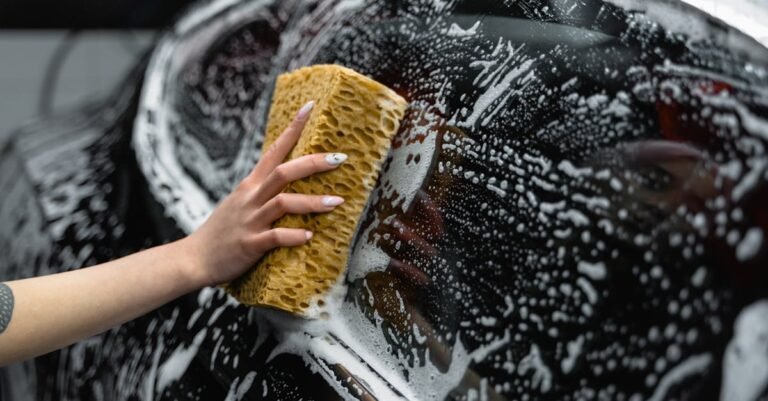Table of Contents
- Detailing Your Car Interior: A Comprehensive Guide
- Why Bother Detailing Your Car Interior? (More Than Just Looks!)
- Gathering Your Arsenal: Essential Tools and Supplies
- The Step by Step Interior Detailing Process
- Step 1: Declutter and Remove Mats
- Step 2: The Big Vacuum – Getting the Loose Stuff
- Step 3: Tackling Carpets and Upholstery
- Step 4: Wiping Down Hard Surfaces (Dashboard, Doors, Console)
- Step 5: Cleaning Leather Seats (If You Have Them)
- Step 6: Sparkling Windows and Mirrors
- Step 7: Applying Protectant
- Step 8: Final Touches (Air Freshener, Mat Placement)
- Pro Tips for a Flawless Finish
- Conclusion: Enjoy Your Pristine Ride!
- Frequently Asked Questions (FAQs)
Detailing Your Car Interior: A Comprehensive Guide
Let’s be honest, we spend a ton of time in our cars. Commuting, road trips, running errands, maybe even grabbing a quick bite between appointments. Over time, the inside of our trusty vehicles can start looking… well, lived in. Crumbs mysteriously multiply, dust settles like a permanent resident, and maybe there’s a lingering scent you just can’t place. Sound familiar? While washing the outside makes your car look good, detailing the inside makes it feel good. It transforms your car from just a mode of transport back into a clean, comfortable, and even healthy space. Think of it like spring cleaning, but specifically for your four wheeled companion. Ready to roll up your sleeves and give your car’s interior the TLC it deserves? This guide will walk you through everything, step by step.
Why Bother Detailing Your Car Interior? (More Than Just Looks!)
Okay, so a clean car interior looks nice. But is it really worth the effort beyond aesthetics? Absolutely! You might be surprised by the tangible benefits that come with regular interior detailing.
Health Benefits: Banishing Germs and Allergens
Your car’s interior can be a breeding ground for germs, bacteria, mold, and allergens. Think about it: spills happen, food crumbs fall into crevices, dust mites make themselves at home in the upholstery, and everything you track in on your shoes gets embedded in the carpets. If you or your passengers suffer from allergies or asthma, a dirty car interior can seriously aggravate symptoms. Detailing involves deep cleaning surfaces, vacuuming hidden spots, and often using cleaners with disinfectant properties. This process physically removes many of these nasties, improving the air quality inside your car and creating a genuinely healthier environment for everyone breathing it in. It’s not just about looking clean; it’s about being clean.
Resale Value: Protecting Your Investment
Your car is a significant investment, right? Keeping the interior in top condition plays a surprisingly large role in maintaining its resale or trade in value. Stains on the seats, worn out carpets, grimy dashboards, and unpleasant odors can drastically lower the perceived value of your vehicle. Potential buyers often judge a car’s overall condition and how well it was maintained by the state of its interior. A clean, well kept interior suggests that the owner cared for the vehicle meticulously. Regular detailing prevents permanent staining, protects surfaces like leather and plastic from cracking or fading due to UV exposure, and keeps everything looking as close to new as possible. It’s an investment in protecting your larger investment.
Driving Experience: A Clean Car Feels Better
There’s just something about sliding into a car that smells fresh and looks spotless. It’s calming, it’s pleasant, and it can genuinely make your drive more enjoyable. A cluttered, dirty car can feel stressful and chaotic – not exactly the vibe you want when navigating traffic or embarking on a long journey. A clean interior, free from distracting grime and clutter, allows you to focus better on the road. It’s like the difference between working at a messy desk versus a clean one; the clean environment promotes a clearer mind. Plus, isn’t there a certain pride in having a car that feels fresh and well maintained inside and out?
Gathering Your Arsenal: Essential Tools and Supplies
Alright, convinced that interior detailing is worth your time? Fantastic! Now, let’s talk about the gear. Having the right tools and products makes the job infinitely easier and yields much better results. You don’t necessarily need professional grade everything, but a few key items are crucial.
Must Have Cleaning Tools
These are the workhorses of your interior detailing kit.
Vacuum Cleaner (with Attachments!)
This is non negotiable. Your household vacuum might work, but a dedicated shop vac or a powerful cordless vacuum often provides better suction and durability for car cleaning tasks. The real game changer, though, is the attachments. You absolutely need a crevice tool to get into those tight spots between seats, around the center console, and in door pockets. A brush attachment is perfect for agitating dirt on carpets and upholstery before sucking it up, and an upholstery tool covers larger fabric areas efficiently.
Brushes (Various Sizes and Stiffness)
You’ll want an assortment. Soft bristled brushes (like makeup or detailing brushes) are essential for dusting delicate areas like air vents, around buttons, screens, and instrument clusters without scratching. Medium stiffness brushes are great for scrubbing carpets, floor mats, and durable upholstery. A stiffer brush might be needed for stubborn spots on carpets, but use it cautiously to avoid damaging fibers. Having various sizes helps you tackle everything from wide open floor spaces to tiny little crevices.
Microfiber Towels (Lots of Them!)
Ditch the old cotton rags! Microfiber towels are the gold standard for car detailing. Why? Their unique structure traps dirt and absorbs liquids far more effectively than cotton, and they are much less likely to leave lint or streaks behind. You’ll need several: some for applying cleaners, some for wiping surfaces dry, separate ones for glass to prevent streaks, and maybe a dedicated one for applying protectants. Having a good stash means you’re always grabbing a clean, dry towel, which is key for a flawless finish.
Essential Cleaning Solutions
Choose products specifically designed for automotive interiors whenever possible, as they are formulated to be safe and effective on the materials found in cars.
All Purpose Cleaner (APC)
A good quality automotive APC is incredibly versatile. It can be used (often diluted) on plastic trim, vinyl, door panels, kick plates, and sometimes even lightly soiled carpets or upholstery (always test first!). Look for one that cleans well without leaving a greasy residue. Avoid harsh household cleaners, which can damage or discolor car interior surfaces.
Upholstery/Carpet Cleaner
For fabric seats and carpets, you’ll need a dedicated cleaner. These come in sprays, foams, or liquids designed to break down dirt and lift stains from fabric fibers. Some even require agitation with a brush and then vacuuming or wiping away. Choose one appropriate for the type of fabric in your car.
Leather Cleaner & Conditioner (If Applicable)
If your car boasts luxurious leather seats or trim, using the wrong cleaner can dry out the leather, causing it to crack and fade over time. Invest in a dedicated two step system: a pH neutral leather cleaner to gently lift dirt and oils from the pores, and a leather conditioner to replenish moisture and protect against UV damage. This keeps leather looking and feeling soft and supple.
Glass Cleaner
Streaky windows are annoying and can impair visibility. Use an automotive specific glass cleaner that’s ammonia free. Ammonia can damage window tint and certain interior plastics or vinyls if overspray occurs. Use two microfiber towels: one to apply the cleaner and scrub, and a second, clean, dry one to buff to a streak free shine.
Interior Protectant (UV Protection)
After cleaning plastics, vinyl, and rubber surfaces (like the dashboard and door panels), applying a protectant is a crucial final step. These products often contain UV blockers that help prevent fading, cracking, and discoloration caused by the sun’s harsh rays. Opt for one with a matte or satin finish rather than a super glossy one, as glossy finishes can create glare while driving and often attract more dust.
The Step by Step Interior Detailing Process
Okay, tool belt loaded? Cleaners at the ready? Let’s dive into the actual cleaning process. Remember, patience and thoroughness are key!
Step 1: Declutter and Remove Mats
Before you even think about vacuuming or scrubbing, get everything out! Remove floor mats (both carpet and rubber), trash, empty coffee cups, stray toys, old receipts, chargers, sunglasses – everything that doesn’t permanently belong in the car. Check door pockets, the glove box (maybe organize it while you’re at it?), under the seats, and in the trunk if you’re doing that too. This gives you clear access to all surfaces. Shake out the floor mats outside the car to dislodge loose dirt.
Step 2: The Big Vacuum – Getting the Loose Stuff
Now, grab your vacuum and those trusty attachments. Start vacuuming everything thoroughly. Begin with the largest areas like the carpets and seats, then switch to your attachments.
Cracks, Crevices, and Under Seats
This is where the crevice tool earns its keep. Methodically vacuum along seams in the upholstery, between the seats and the center console (a notorious crumb collector!), in cup holders, door pockets, and air vents. Slide the front seats all the way forward to vacuum underneath them, then slide them all the way back to get the area in front. Don’t forget the pedals and the driver’s footrest area. Use the brush attachment to loosen stubborn dirt from carpets or fabric seats as you go.
Step 3: Tackling Carpets and Upholstery
With the loose debris gone, it’s time to deep clean the fabrics. If your floor mats are carpeted, clean them outside the car first using your upholstery/carpet cleaner and a brush, then set them aside to dry completely. For the car’s carpets and fabric seats:
Spot Treatment for Stains
Address any specific stains first. Apply your chosen carpet/upholstery cleaner directly to the stain (following product instructions – don’t oversaturate). Let it dwell for a few moments, then gently agitate with a medium stiffness brush or a microfiber towel, working from the outside of the stain inward to prevent spreading. Blot the area with a clean microfiber towel to lift the stain and cleaner. Repeat if necessary.
Deep Cleaning Methods
For general cleaning or heavily soiled areas, you might spray the cleaner lightly over a section, agitate with a brush to lift the dirt, and then wipe away with a clean microfiber towel or vacuum up if using a foam cleaner. For a deeper clean, some people use portable carpet extractors, which spray cleaning solution and then suck the dirty water back up. Whatever method you use, avoid soaking the fabric, as this can lead to mold and mildew issues. Ensure good ventilation (open doors/windows) to help things dry.
Step 4: Wiping Down Hard Surfaces (Dashboard, Doors, Console)
Now, let’s move to the plastics, vinyl, and rubber components. Grab your APC and a clean microfiber towel.
Using Your APC Effectively
It’s usually best to spray the APC onto your microfiber towel rather than directly onto the surface, especially near electronics or vents. This prevents overspray and gives you more control. Wipe down the dashboard, center console, door panels, steering wheel, gear shifter, pillar trims, and any other hard surfaces. For textured plastics or dirtier areas, you might need gentle agitation with a soft brush after applying the cleaner with the towel.
Don’t Forget the Details (Vents, Buttons, Cup Holders)
Use your soft detailing brushes and crevice tools here. Spray a little APC onto the brush (or use a dedicated interior detailer spray) and gently clean around buttons, switches, infotainment screen bezels (careful with the screen itself!), air vent slats, speaker grilles, and inside cup holders. A cotton swab dipped lightly in cleaner can also be helpful for super tight spots. Wipe away any residue with a clean microfiber.
Step 5: Cleaning Leather Seats (If You Have Them)
Leather requires specific care. Apply your pH neutral leather cleaner to a microfiber applicator pad or towel. Gently wipe down the leather surfaces, section by section. Don’t scrub aggressively. The cleaner should lift dirt and oils from the grain. Wipe away any residue with a separate clean microfiber towel. Follow up immediately (or once dry, depending on the product) with the leather conditioner. Apply a small amount to another clean applicator, massage it gently into the leather, and let it absorb for the time specified on the product label. Buff off any excess conditioner with a final clean microfiber towel.
Step 6: Sparkling Windows and Mirrors
Clean glass makes a huge difference. Lightly mist your ammonia free glass cleaner onto one microfiber towel. Wipe the inside of the windows and the rearview mirror. Flip the towel to a drier side or use a second, completely dry microfiber towel (a waffle weave glass towel works wonders) to buff the glass to a streak free shine. Roll the windows down slightly to clean the very top edge that tucks into the seal.
Step 7: Applying Protectant
Once the hard surfaces (dashboard, door panels, vinyl trim) are clean and dry, it’s time to protect them. Apply a small amount of your chosen interior protectant (preferably with UV inhibitors and a non greasy finish) onto a microfiber applicator pad or towel. Wipe it evenly onto the surfaces. A little goes a long way. Buff off any excess with a clean, dry microfiber towel to ensure an even, non streaky finish.
Step 8: Final Touches (Air Freshener, Mat Placement)
Almost there! Once everything is clean, protected, and dry (ensure carpets and mats are fully dry before replacing them to prevent mold), you can add the finishing touches. Place your clean, dry floor mats back into the car. If you like, add a subtle air freshener – choose something light and pleasant, not overpowering. Step back and admire your hard work!
Pro Tips for a Flawless Finish
Want to elevate your interior detailing game? Keep these tips in mind.
Work from Top to Bottom
Just like cleaning a room in your house, work from the highest point downwards. Clean the headliner (carefully, usually just light spot cleaning is needed), then the dashboard and vents, then the console and doors, and finally the seats and carpets. This way, any dust or dirt you dislodge falls onto areas you haven’t cleaned yet, preventing you from having to redo work.
Test Cleaners in Inconspicuous Areas
Before applying any cleaner (especially APC, upholstery cleaner, or leather cleaner) liberally, test it on a small, hidden spot first. Underneath a seat, on a carpet section usually covered by a mat, or the side of the console are good places. Check for any discoloration or adverse reactions before proceeding with the entire area. Better safe than sorry!
Don’t Soak Electronics!
Be extremely careful around infotainment screens, instrument clusters, buttons, and switches. Never spray cleaners directly onto these areas. Instead, spray onto your microfiber towel or detailing brush first, and use minimal moisture. Water and electronics do not mix well, and repairs can be costly.
Conclusion: Enjoy Your Pristine Ride!
And there you have it! Detailing your car’s interior might seem daunting at first, but breaking it down step by step makes it totally manageable. It’s more than just cleaning; it’s about restoring comfort, preserving value, and creating a healthier space for you and your passengers. The satisfaction of sitting in a genuinely clean, fresh smelling car that you detailed yourself is hard to beat. So grab your supplies, put on some music, and give your car the interior spa day it deserves. Happy detailing, and enjoy the incredibly rewarding feeling of driving a sparkling clean car!
Frequently Asked Questions (FAQs)
How often should I detail my car interior?
This really depends on your usage and personal preference. A good deep clean or “full detail” like the one described here is often recommended every 3 to 6 months. However, regular light maintenance like vacuuming, wiping down surfaces, and removing trash weekly or bi weekly will make the deeper cleans much easier and keep your interior looking great year round.
Can I use household cleaners on my car interior?
It’s generally not recommended. Household cleaners (like dish soap, glass cleaner with ammonia, or all purpose sprays) can be too harsh for automotive materials. They might strip protective coatings, dry out leather, stain upholstery, or damage plastics and vinyl. Always opt for products specifically formulated for automotive interiors for the best and safest results.
What’s the best way to remove pet hair?
Pet hair can be stubborn! Start by vacuuming thoroughly. Then, try using a rubber brush, a squeegee, or even a damp rubber glove dragged across the upholstery – these tools can often pull embedded hair out effectively. A pumice stone designed for pet hair removal (use gently!) or specialized pet hair vacuum attachments can also work wonders on carpets and sturdy fabrics.
How do I get rid of bad smells in my car?
First, find and eliminate the source! Clean up any spills, remove old food or trash, and deep clean carpets and upholstery where odors might be trapped. Baking soda sprinkled on carpets overnight before vacuuming can absorb some odors. Using an odor eliminator spray (not just an air freshener that masks smells) can help neutralize lingering scents. Sometimes, replacing the cabin air filter makes a huge difference too.
Is professional interior detailing worth it?
It certainly can be! Professionals have specialized tools (like hot water extractors and steam cleaners), high quality products, and extensive experience. They can often achieve results difficult for a DIYer, especially with heavy staining, embedded odors, or delicate materials. If you lack the time, tools, or inclination to do a thorough job yourself, or if your car needs serious intervention, professional detailing is a great investment.









